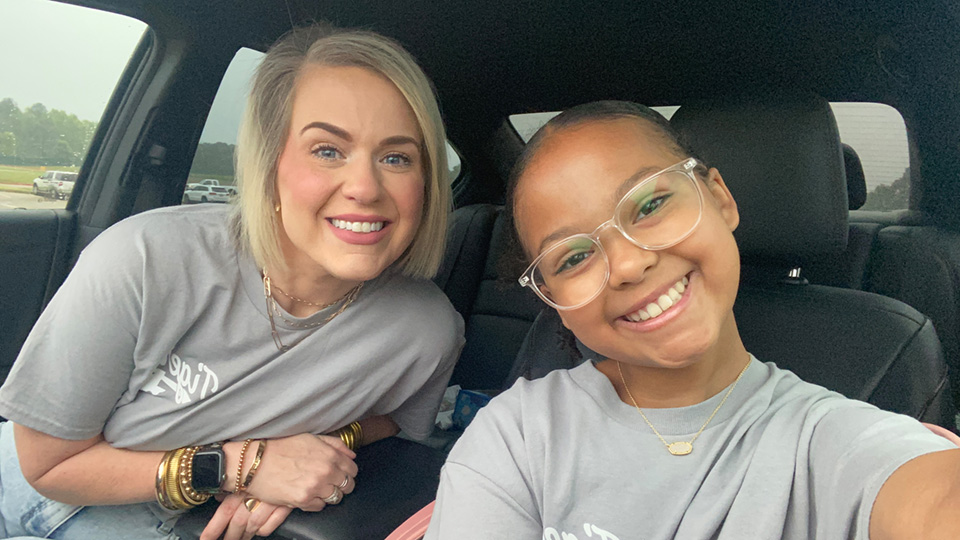How an Analytical Mind Became This Adult’s “Superpower…
Eczema Ambassador Bryan shares how his analytical mind became a superpower for tracking symptoms and finding community.

Published On: Oct 25, 2024
Last Updated On: Oct 25, 2024
Chayse, 11, from Texarkana, Arkansas, has had atopic dermatitis, the most common form of eczema, since she was a baby. After her symptoms first appeared, her parents spent several months consulting multiple doctors before receiving an accurate diagnosis, a process that her mother, Kacey Jenkins, remembers as being especially challenging for her own confidence.
Since then, Kacey has focused on empowering Chayse to feel comfortable in her own skin. In a conversation with the National Eczema Association (NEA), Kacey shared more of Chayse’s eczema journey and how she taught her young daughter to talk openly about her diagnosis with confidence.
The interview has been condensed for length and clarity.
Kacey Jenkins (KJ): Initially, you grasp at any recommendations you receive from your healthcare provider. But then, when a potential solution doesn’t work, you start to think, “I must be doing something wrong because my doctor said this should help.” The mom guilt sets in because everyone’s saying, “you must not be following the directions correctly” and you start to question your own ability to care for your child. It’s exhausting.
KJ: As parents, our children take cues from us. So even if I’m sitting here questioning my own abilities, I put on a face that says, “We’re going to take care of this. You don’t need to worry, we’ve got this.”
I never wanted Chayse to think there was something wrong with her. Her eczema was just something we managed. We took a very matter-of-fact approach like, “OK, it’s time to apply lotion to your skin” and didn’t make it a big deal.
That’s just my style of parenting as well. And I think it’s important to remember that talking about eczema isn’t a one-and-done conversation. Unless a cure is found, this will be an ongoing conversation for families.
KJ: This is the only skin Chayse knows, so it’s normal for her. But I also remind her that her eczema doesn’t define her.
She’ll make sidebar comments sometimes. For example, when we were talking about her school’s dress code, I told her to keep her shorts down because her backpack would pull them up. Chayse told me, “Yeah, to cover up those spots on the back of my legs.”
I responded, “Absolutely not, who cares about that! A lot of people have eczema.” So, while she’s very aware of her eczema, we teach her that she doesn’t have to conceal it.
KJ: In those true “why me” moments, I answer her honestly. I don’t know why she has eczema, but I’m glad we have the ability to learn about it and find solutions that help her.
We’ve cried about it together and I’ve let Chayse know it’s fine to feel frustrated at times because she’s the one living in her skin. I let her know I’m here to support her, and I don’t let her dwell in those moments for very long.
KJ: It started early in how to talk to classmates in pre-kindergarten. I gave her the language, “Don’t worry, we can still play and share toys.”
I didn’t tell her to say, “This is just a rash” or “this is just a boo-boo.”
I gave her the actual words. I need her to be able to speak about her eczema when I’m not around and have that autonomy.
That’s why it was always, “This is just my eczema. It itches me sometimes, and I have to put on lotion, but it doesn’t prevent me from being your friend.”
The language has obviously evolved as she’s gotten older. If she’s not sure how to explain something, she’ll say to a friend, “If your mom or dad has questions, I can give you my mom’s phone number.”
KJ: Chayse went from having 60 kids in her elementary class to a larger middle school with hundreds of sixth graders. She’s experiencing a lot of new personalities.
When someone points out her skin, Chayse just says, “Yes, it’s eczema. It’s very common and people have different types.”
She really shuts down any negativity because her attitude is, “I’m not going to engage in that kind of back-and-forth. You can’t make me feel bad about something that I don’t feel bad about.” We wanted to instill that confidence in her from an early age and give her that power.
Again, we taught Chayse to not be ashamed of her eczema. Now that she’s in middle school, Chayse has classmates asking her if they have eczema if they are experiencing dry skin or itchiness. And she’ll say, “I’m not sure, but here, try some of my lotion.”
KJ: Chayse really has embraced it. She recognizes that she has a voice and she can reach others who may not feel as confident about their diagnosis. Her goal is to help other people feel good about themselves.
The National Eczema Association has partnered with Understand AD™, supported by Sanofi and Regeneron, to create an educational campaign that helps empower people living with eczema (atopic dermatitis) — and their caregivers — with the tools they need to speak up about the impacts of this disease. This year, Understand AD aims to encourage members of the eczema community to “color their confidence,” with a featured series of animated videos that highlight real people and moments in their lives where they felt confident in their skin and sharing their experience with their friends and community. Check out Kacey and Chayse’s video to learn more about their experience — plus find other eczema resources and support — on UnderstandAD.com.